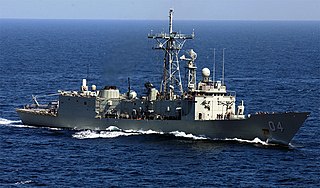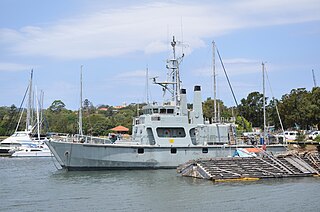
HMAS Darwin, named for the capital city of the Northern Territory, was an Adelaide-class guided-missile frigate, formerly in service with the Royal Australian Navy (RAN). One of four ships ordered from the United States, Darwin entered service in 1984. During her career, she has operated in the Persian Gulf, as part of the INTERFET peacekeeping taskforce, and off the Solomon Islands. The frigate underwent a major upgrade during 2007 and 2008. She was decommissioned on 9 December 2017 and was supposed to be scuttled as a dive wreck in Tasmania, but the deal was pulled by the Tasmanian Government and her fate remains uncertain.

HMAS Newcastle, named for the city of Newcastle, New South Wales, the largest provincial city in Australia, was an Adelaide-class guided-missile frigate. The last ship of the class to be constructed, Newcastle entered service with the Royal Australian Navy in 1993. During her career, the frigate has operated as part of the INTERFET peacekeeping taskforce, served in the Persian Gulf, and responded to the 2006 Fijian coup d'état. The frigate was decommissioned on 30 June 2019 and transferred to the Chilean Navy on 15 April 2020 and renamed as Capitán Prat.

HMAS Otama was an Oberon-class submarine, formerly of the Royal Australian Navy (RAN). Built in Scotland, the submarine was the last of the class to enter service when commissioned into the RAN in 1978. Otama was a specialist, one of two "Mystery Boats", fitted with additional surveillance and intelligence-gathering equipment. Otama was routinely deployed on classified operations to obtain intelligence on Soviet Pacific Fleet vessels and Chinese Navy vessels, and conducted associated coastal surveillance, throughout Asia.

HMAS Ovens is an Oberon-class submarine, formerly of the Royal Australian Navy (RAN). She was one of six Oberons built for the Royal Australian Navy by the Scottish Scotts Shipbuilding and Engineering Company, and entered service in 1969. The vessel was named for Irishman and Australian explorer John Ovens (1788–1825) and for whom the Victorian river Ovens was named. During her career, Ovens was the first RAN submarine to deploy with the ANZUK force, and the first RAN submarine to fire an armed Mark 48 torpedo, sinking the target ship Colac. The boat was decommissioned in 1995, and is preserved at the Western Australian Maritime Museum as a museum ship.

The 1942 Design Light Fleet Carrier, commonly referred to as the British Light Fleet Carrier, was a light aircraft carrier design created by the Royal Navy during the Second World War, and used by eight naval forces between 1944 and 2001. They were designed and constructed by civilian shipyards to serve as an intermediate step between the expensive, full-size fleet aircraft carriers and the less expensive but limited-capability escort carriers.

HMS Vengeance (R71) was a Colossus-class light aircraft carrier built for the Royal Navy during World War II. The carrier served in three navies during her career: the Royal Navy, the Royal Australian Navy, and the Brazilian Navy.

HMAS Rushcutter was one of two Bay class minehunters built for the Royal Australian Navy by Carrington Slipways at its Ramsay Fibreglass facility in Tomago, New South Wales. She was launched on 8 May 1986 and commissioned on 1 November 1986. She was decommissioned on 14 August 2001. She and sister ship HMAS Shoalwater were sold in 2002 for service in the Persian Gulf. At some point before 2013, the vessel ended up in private hands in Rozelle Bay.

HMAS Adelaide was the lead ship of the Adelaide class of guided missile frigates built for the Royal Australian Navy (RAN), based on the United States Navy's Oliver Hazard Perry-class frigates. She was built in the United States and commissioned into the RAN in 1980.

HMAS Parramatta is an Anzac-class frigate of the Royal Australian Navy (RAN). One of ten warships built for the RAN and Royal New Zealand Navy (RNZN) based on the MEKO 200 design, Parramatta was laid down in 1999, launched in 2003, and commissioned into the RAN in 2003. During her career, the frigate has been deployed to the Middle East on several occasions. In early 2015, Parramatta was docked to undergo the Anti-Ship Missile Defence (ASMD) upgrade. She completed these upgrades in April 2016.

HMAS Sydney was an Adelaide-class guided-missile frigate of the Royal Australian Navy (RAN). The frigate was one of six modified Oliver Hazard Perry-class frigates ordered from 1977 onwards, and the third of four to be constructed in the United States of America. Laid down and launched in 1980, Sydney was named for the capital city of New South Wales, and commissioned into the RAN in 1983.

HMAS Anzac was the lead ship of the Anzac-class frigates in use with the Royal Australian Navy (RAN) and the Royal New Zealand Navy (RNZN). Entering Australian service in 1996, the frigate operated as part of the INTERFET peacekeeping taskforce in 1999. In 2003, she was involved in the Battle of Al Faw, and became the first RAN ship to fire in anger since the Vietnam War.

HMAS Arunta is an Anzac-class frigate of the Royal Australian Navy (RAN). The ship, named for the Arrernte people, was laid down in 1995 and commissioned in 1998. Since entering service, Arunta has performed a wide range of duties, including border protection patrols in northern Australian waters, and several deployments to the Persian Gulf.

HMAS Perth is an Anzac-class frigate of the Royal Australian Navy (RAN). The last ship of the class to be completed, she was built by Tenix Defence and commissioned into the RAN in 2006. In 2007, Perth became the first major warship of the RAN to be commanded by a woman. During 2010 and 2011, the frigate was used as the testbed for a major upgrade to the Anzac class' ability to defend themselves from anti-ship missiles.

HMAS Warramunga is an Anzac-class frigate of the Royal Australian Navy (RAN). One of ten frigates built for the Australian and New Zealand navies, Warramunga was laid down by Tenix Defence in 1997 and commissioned in 2001. During her career, the frigate has operated in the Persian Gulf as part of Operation Catalyst, and undertaken anti-piracy operations off Somalia. Warramunga underwent the Anti-Ship Missile Defence (ASMD) upgrade during 2014. She is active as of October 2022.

HMAS Ballarat is an Anzac-class frigate of the Royal Australian Navy (RAN). The frigate was laid down in 2000 and commissioned into the RAN in mid-2004. Since entering service, Ballarat has been involved in border protection as part of Operation Relex II, was deployed to the Gulf for Operation Catalyst, and was one of the two ships involved in the Operation Northern Trident 2009 round-the-world voyage. Ballarat has undergone the Anti-Ship Missile Defence (ASMD) upgrade, completing in 2015.

HMAS Melbourne was an Adelaide-class guided-missile frigate of the Royal Australian Navy, which entered service in 1992. Melbourne has been deployed to the Persian Gulf on several occasions, and served as part of the INTERFET peacekeeping taskforce in 2000. On 26 October 2019, Melbourne was decommissioned from the RAN, subsequently being transferred to Chile. The ship was commissioned into the Chilean Navy as Almirante Latorre on 15 April 2020.

The Huon-class minehunter coastal (MHC) ships are a group of minehunters built for the Royal Australian Navy (RAN). Following problems with the Bay-class minehunters, a request for tender was issued in 1993 for a class of six coastal minehunters under the project designation SEA 1555. The tender was awarded in 1994 to the partnership of Australian Defence Industries (ADI) and Intermarine SpA, which was offering a variant of the Italian Gaeta-class minehunter.

The Bay-class Minehunter Inshores were a class of catamaran-hull mine warfare vessels operating with the Royal Australian Navy from 1986. Also referred to as the MHCAT, the class was an attempt to produce a locally designed inshore mine warfare vessel. Two prototype ships were ordered in 1981, with the first ship, Rushcutter, commissioned in November 1986. The two ships experienced delays in construction, and the RAN resorted to acquiring six minesweeper auxiliaries (MSA) under the Craft of Opportunity Program to provide an interim mine-warfare capability, while also keeping Ton-class minesweeper HMAS Curlew in service until 1990, well beyond her intended decommissioning date. The ships did not enter service until 1993, due to problems with the sonar.

HMAS Otway was an Oberon-class submarine of the Royal Australian Navy (RAN). One of the first four Oberon-class boats ordered for the RAN, Otway was built in Scotland during the mid-1960s, and commissioned into naval service in 1968. The submarine was decommissioned in 1994. The submarine's upper casing, fin, and stern are preserved at Holbrook, New South Wales.

HMAS Melville is the second ship of the Leeuwin class of hydrographic survey vessels operated by the Royal Australian Navy (RAN). The ship was decommissioned on 8 August 2024.



















